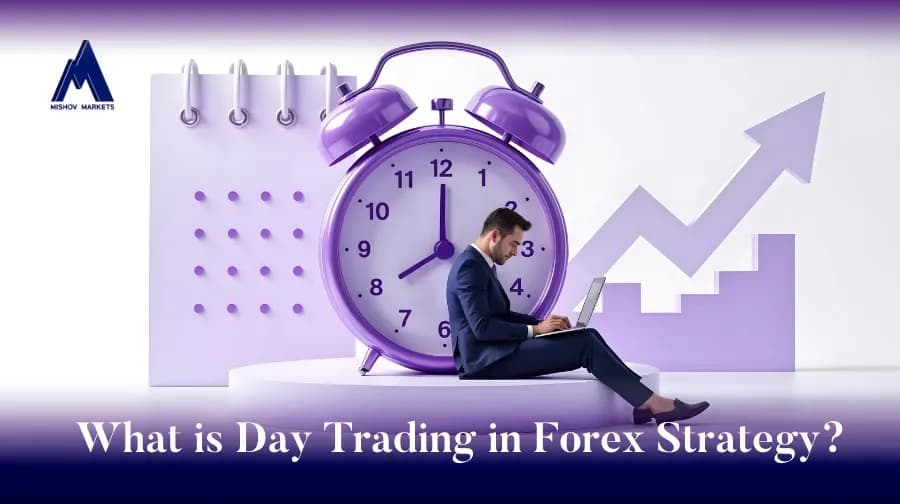What is day trading in forex strategy

Day Trading in forex strategy or which one of the forex strategies aligns best with a trader’s goals and lifestyle? Is there a strategy that can still be profitable while having a full-time job and limited time for trading? Choosing the right strategy is crucial, especially if you can’t dedicate hours to monitoring the markets.
In this article, we dive deep into one popular strategy—Day Trading. This strategy can be an advantageous approach for those who understand its dynamics, and it also requires traders to be quick decision-makers and manage time carefully. Before jumping in, read carefully to discover what day trading is, and whether it could be for someone with a busy schedule. Let’s get started!
Day trading in forex strategy refers to the practice of buying and selling currency pairs within one trading day. Unlike long-term trading strategies, day traders close their positions by the end of the trading session.
This way, they can avoid the risk of holding trades overnight. This short-term trading strategy requires keen attention to market fluctuations, technical analysis, and the ability to make quick decisions. Usually, traders in the forex market are more interested in capitalizing on short-term price movements in highly liquid currencies such as EUR/USD, GBP/USD, and more.
Day trading in forex strategy is a fast-paced method where traders’ goal to generate revenue is by taking advantage of small price changes throughout the day. The difference between day trading and swing trading or position trading is that they involve holding trades for several days or even weeks if necessary. Forex day traders use a combination of chart patterns, forex indicators, and news analysis to identify potential trading opportunities.
How Does Day Trading Forex Work?
Day trading strategy in forex operates in the global forex market, where currencies are traded in pairs. Traders pay attention to economic events, political news, and technical factors to exploit these factors' volatility and profit from them.
We have broken down this procedure into four steps:
-
Market analysis: Day traders start by analyzing the forex market by using technical indicators like moving averages, RSI (Relative Strength Index), or MACD (Moving Average Convergence Divergence). These tools help traders predict short-term price movements.
-
Entry and Exit Points: Traders identify entry points where they deem the currency pair will move in their favor. Once a position is entered, traders start monitoring their trades, set stop-loss, and take profit levels to limit risk and lock profits.
-
Leverage: Brokers in forex offer leverage, which allows traders to control large positions with a small amount of capital. However, this also amplifies the risk. This means traders will have either substantial losses or gains.
-
Timing: Timing is critical in day trading. Forex markets are most volatile when the major sessions overlap, such as the London and New York sessions. Day traders often trade during these times to take advantage of increased liquidity and price fluctuations.
In day trading, markets move rapidly so making decisions quickly is very important. A day trader’s success relies on their ability to enter and exit trades swiftly, sometimes within minutes.
Is Day Trading Allowed in Forex?
Yes, day trading is allowed in the forex market. In fact, day trading is very compatible with the forex market due to its having high liquidity, 24-hour accessibility, and the benefit of leverage. Unlike some stock markets with different limitations, forex trading has fewer restrictions, allowing traders from all around the globe to engage freely in day trading.
Mishov Markets offers the necessary tools and platform (MT5) specifically designed for day traders, including real-time charts, fast execution speeds, and various order types. Start your demo account now and experience trading in a risk-free environment.
Types of Day Trading in Forex Strategy
There are several types of day trading strategies used in the forex market, each catering to different trading styles and risk tolerance levels. The most common types include scalping, range trading, trend following, and news trading.
Scalping, which is a fast-paced strategy focused on making small profits from quick price movements. Range trading is also a type of day trading and it involves identifying support and resistance levels and trading within a defined price range.
Trend trading, on the other hand, looks to capitalize on sustained market trends.
New trading is also a kind of day trading that turns around major economic releases and news events that can cause significant price volatility.
Forex Day Trading Rules
Successful forex day trading requires discipline and adherence to a set of rules. These rules are there to help traders minimize risk and maximize their chances of consistent profits under different market conditions. Key rules include:
-
Having a trading plan: A solid trading plan is essential for any trading strategy including day trading strategy. The plan for day traders should include entry and exit points and strategy, risk management, and rules for trade sizes.
-
Using Risk Management: One of the crucial rules in forex daytrading is risk management. Traders should never risk more than 1-2% of their trading capital on a single trade. This ensures traders stay safe without a huge loss, even if multiple trades go wrong.
-
Stay Informed: Day traders must stay updated on market news and economic events that can potentially affect forex prices. Being informed helps traders anticipate market moves.
-
Stick to Your Strategy: it’s crucial for day traders to follow their strategy even in high-pressure situations. Consistency and discipline are key. However, traders should be flexible with their strategies and be able to make adjustments to them if necessary.
How to Start Day Trading Forex
To start day trading in forex, there are some essential steps traders should take before jumping in.
Before you start day trading, invest time in learning about the forex market then learn forex day trading, how it operates, and how the strategies work best Mishov Markets offers educational resources for their clients such as videos, private consultations, and around-the-clock support.
Selecting the right broker is as important as choosing the right strategy. Choose a broker that offers a reliable trading platform, fast executions, and access to several currency pairs.
Many brokers offer demo accounts, which allow traders to experience and practice trading without risking real money. This is an excellent way for beginners to familiarize themselves with the platform and develop their skills before starting in a real environment.
When traders feel ready to start trading in a real account, they are highly advised to start with small trade sizes. This reduces the risk while they still gain experience.
Forex Day Trading for Beginners
Sticking to major pairs: traders should start by trading major currency pairs like EUR/USD, and GBP/USD which offer high liquidity and tighter spreads.
Mastering a strategy: Traders should master one or two strategies rather than trying different ones on each trade.
Avoid overtrading: All traders are advised to avoid overtrading but especially beginners. Also, beginners should avoid holding onto a position for too long. Keep emotions in check and follow your plan.
Summary
Day trading in forex strategy is an exciting way to engage in the financial markets. By learning the right strategy and implementing a suitable way, traders can master day trading and use it profitably. By applying discipline and practicing risk management, traders can succeed in this fast-paced environment. For beginners, the journey requires patience and a willingness to learn forex day trading through both success and failure. With Mishov Markets, get in contact with experts and practice day trading in a demo account now. Experience forex in a risk-free environment.








